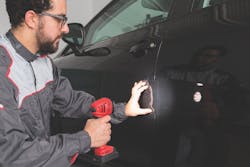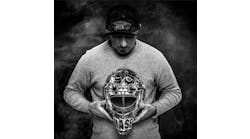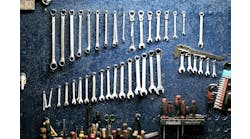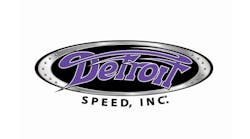Color matching can be one of the most frustrating tasks for a painter and, as Edward LaBelle, painter at Milosch’s Palace Chrysler in Lake Orion, Mich., describes it, hair-pulling inducing parts of the painting process. But with the right techniques, and access to helpful outside resources, each color variant on every vehicle can be matched quickly and efficiently.
LaBelle has been in the industry for over 25 years. He started as a temp directly after high school, and has worked his way up to being a talented painter and industry mentor to those around him. The Painter’s Playbook sat down with LaBelle to uncover a few of his paint matching tips and thoughts on how to overcome some of the largest challenges.
What equipment and tools do you use to be able to color match efficiently at your shop?
Your most important tool is your eye—that’s what it all comes down to when color matching. At my shop, we always have more than one person look at the color. Because sometimes what you see can be a little bit different from what another person sees. So we like to have two people look at each color. And believe it or not, women see color better than men do.
As far as other tools, we also use what’s called a photo spectrophotometer, which is like a scanner. It takes a picture of the color and then searches through an extensive database for a match. It will also tint a color for you, if that’s what you feel you need to do. A high quality color correct LED light is also an ideal tool for matching color.
Do you utilize a color library?
I have an extensive library of colors where I try to keep as many sprayouts as I can, just for future reference. That way I can go back and look at what I’ve done, and use the same formula if another car comes up with that same color.
I keep everything in my library labeled and categorized. I can go right to the specific color and, more than likely, I can find what I need pretty quickly.
The best way that I’ve found to organize my library is by making a cabinet and adding little hooks. That way I can just hang my sprayouts instead of clumping them all together, throwing them in a cabinet or a drawer, and then having to take the time to fish through them when needed.
Being well-organized is definitely the best way to go.
What do you think are some of the largest challenges painters face when color matching?
One of the biggest challenges would be trying to match the color of a car that’s already been previously repaired. This is because the vehicle might appear as all the same color, but actually, has two different variances of that color on each side of the car. I’ve seen vehicles that have even more than two colors. So sometimes, you have to mix up two different colors when you’re painting the vehicle to match both sides.
I also think color matching has become more and more difficult as years go on. It seems like every year, they come up with a more difficult color that you have to work with. It’s gone from 2-stage colors to now where almost everything is a 3-stage color.
What resources do you recommend in order to tackle some of these challenges?
There are plenty of helpful resources out there. Every paint line has a class on color matching, and those are very important when you’re in the business. I’ve gone to quite a few of them, and try to go at least every five years to freshen up on what’s new out there. The classes also touch on the different techniques for each paint line, since every line is different when it comes to color matching.
Each paint manufacturer also has loads of information on their website to look at.
Your paint company usually has information as well, and can even send techs out to help you if you are struggling. There are times when a new color comes out and there isn’t much information on it, so instead of spending an entire day trying to tint the color, you can bite the bullet and call someone to do it for you.
Any final color matching tips and tricks you have picked up over the years?
My biggest tip is to always do sprayouts in order to check your color. Because if you check your color before you clear it, that’s gonna solve everything, and you’re going to avoid any future repaints.
As for lighting, sunlight is the best—if you can pull it outside and check, because that’s ultimately where the customer is going to see their car.
Sponsored by




